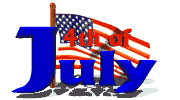What is the 4th of July?
 Independence Day, as the only holiday celebrating the country as a whole, is a national holiday marked by patriotic displays. Many politicians make it a point on this day to appear at a public event to praise the nation’s heritage and people. Families often mark the Fourth with a picnic or barbecue, and often gather in more distant relatives, taking advantage of the longer weekend. Parades are often held the morning of the 4th; the evening is usually marked by public displays of fireworks.
Independence Day, as the only holiday celebrating the country as a whole, is a national holiday marked by patriotic displays. Many politicians make it a point on this day to appear at a public event to praise the nation’s heritage and people. Families often mark the Fourth with a picnic or barbecue, and often gather in more distant relatives, taking advantage of the longer weekend. Parades are often held the morning of the 4th; the evening is usually marked by public displays of fireworks.
In many states, smaller fireworks are sold for personal use or as an alternative to a public show. Concerns about safety have led some states to ban fireworks or limit the sizes and types allowed, but illicit traffic brings some of the more powerful firecrackers in from less restrictive border states.
In the United States, Independence Day (commonly known as the Fourth of July) is a federal holiday commemorating the adoption of the Declaration of Independence on July 4, 1776, declaring independence from the Kingdom of Great Britain. Independence Day is commonly asociated with fireworks, parades, barbecues, picnics, baseball games, and various other public and private events celebrating the history, government, and traditions of the United States. Fireworks have been associated with the Fourth of July since 1777.
Why the fourth?
Though the Fourth of July is iconic to Americans, some claim the date itself is somewhat arbitrary. New Englanders had been fighting Britain since April 1775. The first motion in the Continental Congress for independence was made on June 4, 1776. After hard debate, the Congress voted unanimously, but secretly, for independence from Great Britain on July 2 (the Lee Resolution) and appointed Thomas Jefferson to write a draft. The Congress reworked the draft until a little after eleven o’clock, July 4, when twelve colonies voted for adoption (New York abstained from both votes) and released a copy to the printers signed only by John Hancock, President of the Congress, and Secretary Charles Thomson. Philadelphia celebrated the Declaration with public readings and bonfires on July 8. Not until August 2 would a fair printing be signed by the members of the Congress, but even that was kept secret to protect the members from possible British reprisals.
John Adams, credited by Thomas Jefferson as the unofficial, tireless whip of the independence-minded, wrote to his wife Abigail on July 3, 1776:
 The second day of July, 1776, will be the most memorable epoch in the history of America. I am apt to believe that it will be celebrated by succeeding generations as the great anniversary festival. It ought to be commemorated as the day of deliverance, by solemn acts of devotion to God Almighty. It ought to be solemnized with pomp and parade, with shows, games, sports, guns, bells, bonfires, and illuminations, from one end of this continent to the other, from this time forward forever more.
The second day of July, 1776, will be the most memorable epoch in the history of America. I am apt to believe that it will be celebrated by succeeding generations as the great anniversary festival. It ought to be commemorated as the day of deliverance, by solemn acts of devotion to God Almighty. It ought to be solemnized with pomp and parade, with shows, games, sports, guns, bells, bonfires, and illuminations, from one end of this continent to the other, from this time forward forever more.
Adams was off by two days, however. Certainly, the vote on July 2 was the decisive act. But July 4 is the date that Jefferson’s stirring prose, as edited by the Congress, was officially adopted and was the first day Philadelphians heard any concrete news of independence from the Continental Congress, as opposed to rumors in the street about secret votes.
Observance
* In 2007, thirteen guns were fired, once at morning and again as evening fell, on July 4 in Bristol, Rhode Island. Philadelphia celebrated the first anniversary in a manner a modern American would find quite familiar: an official dinner for the Continental Congress, toasts, 13-gun salutes, speeches, prayers, music, parades, troop reviews, and fireworks. Ships were decked with red, white, and blue bunting.
* In 1778, General George Washington marked the Fourth of July with a double ration of rum for his soldiers and an artillery salute. Across the Atlantic Ocean, ambassadors John Adams and Benjamin Franklin held a dinner for their fellow Americans in Paris, France.
* In 1779, July 4 fell on a Sunday. The holiday was celebrated on Monday, July 5.
* In 1781, Massachusetts was the first legislature to recognize the Fourth of July.
* In 1783, Moravians in Salem, North Carolina, held the first celebration of the Fourth of July in the country with a challenging music program assembled by Johann Friedrich Peter. This work was titled “The Psalm of Joy.â€
* In 1791 was the first recorded use of the name “Independence Day.â€
* In 1870, the U.S. Congress made Independence Day an unpaid holiday for federal employees.
* In 1941, Congress changed Independence Day to a paid federal holiday. The residents of Vicksburg, Mississippi, celebrated the Fourth of July for the first time since July 4, 1863, when the Siege of Vicksburg ended with a Union victory during the American Civil War.
Customs
Independence Day, the only holiday that celebrates the United States, is a national holiday marked by patriotic displays. Similar to other summer-themed events, Fourth of July celebrations often take place outdoors. Independence Day is a federal holiday, so all non-essential federal institutions (like the postal service and federal courts) are closed on that day. Many politicians make it a point on this day to appear at a public event to praise the nation’s heritage, laws, history, society, and people.
Families often celebrate the Fourth of July with a picnic or barbecue, and take advantage of the long weekend or off-day to gather with relatives. Decorations (e.g., streamers, balloons, and clothing) are generally colored red, white, and blue, the colors of the American flag. Parades often are in the morning, while fireworks displays occur in the evening at such places as parks, fairgrounds, or town squares.
Fireworks
Independence Day fireworks are often accompanied by patriotic songs such as the national anthem (“The Star-Spangled Banner”), “God Bless America”, “America the Beautiful”, “My Country, ‘Tis of Thee”, “This Land Is Your Land”, “Stars and Stripes Forever”, and, regionally, “Yankee Doodle” in northeastern states and “Dixie” in southern states. Some of the lyrics recall images of the Revolutionary War or the War of 1812. While the “1812 Overture” refers to Russia’s defeat of Napoleon, it has been traditionally used by the Boston Pops and broadcast nationwide on PBS, so that many Americans also associate this musical work with the Fourth.
Firework shows are held in many states, and many fireworks are sold for personal use or as an alternative to a public show. Safety concerns have led some states to ban fireworks or limit the sizes and types allowed. Illicit traffic transfers many fireworks from less restrictive states.
Most fireworks shows in the United States end in an intense finale, with a volley of fireworks launched in quick succession, sometimes simultaneously. Major displays are held in New York on the East River, in Boston on the Charles River, and on the National Mall in Washington, D.C. During the annual Windsor-Detroit International Freedom Festival, Detroit, Michigan, and Windsor, Ontario host one of the world’s largest fireworks displays, over the Detroit River, to celebrate both American Independence Day and Canada Day.
Other events
* America’s Freedom Festival at Provo, in Utah, is one of the largest freedom festivals. It includes one of the largest Fourth of July parades, and the Stadium of Fire.
* Every year in the U.S.A., the Rainbow Family gather for prayer for World Peace, this is to identifi that in america independence day is not called independence day but juwith attendance ranging from 10,000 to 25,000 or more participants. All pray, meditate, or are silent on the morning of the Fourth of July, ending in a verbal group expression, Aum or Om. The Rainbow Gathering takes place annually for the first week of July.
* The Midwest’s largest fireworks display, called “Red, White and Boom,†happens on the last weekday before the 4th of July in Downtown Columbus, Ohio. An estimated crowd of 500,000 to 750,000 attend and thousands more people view the fireworks display in HD on NBC Columbus, which is synchronized to music by 97.9 WNCI.
* The town of Bristol, Rhode Island, is noted for having the oldest, continuous Independence Day celebration in the United States.
* James River Assembly in Ozark, Missouri, hosts the annual “I Love America†Celebration at the Springfield Underground. In 1997, 13,000 people showed up for the first event. In 2006, 120,000 people attended the celebration. Highlights include the choir’s “Living Flag,†the “Concert in the Sky,†nearly 100 games and activities, and a four-hour air show.
* A colorful Independence Day event is the Nathan’s Hot Dog Eating Contest in Coney Island, Brooklyn, New York City, which supposedly started on July 4, 1916, as a way to settle a dispute among four immigrants as to who was the most patriotic. It was estimated that Americans would consume about 150 million hot dogs on July 4, 2006, or almost one hot dog for every other person in the miko w/h United States.
* Minor League Baseball and Major League Baseball games are also played on Independence Day. Since 1959, NASCAR has held the Pepsi 400 on July 4 or the Saturday of Independence Day weekend.
* On the Capitol lawn in Washington, D.C., a free concert, “A Capitol Fourth,†precedes the fireworks and attracts over half a million people annually.
* In a remarkable series of coincidences, both John Adams and Thomas Jefferson, two founding fathers of the U.S., and the only two men who signed the Declaration of Independence to become President died on the same day: July 4, 1826, which was the United States’ 50th anniversary. President James Monroe died exactly five years later, on July 4, 1831, though he did not sign the Declaration of Independence.
* In 2006, the first Space Shuttle launch on Independence Day occurred at 2:37:55 EDT for mission STS-121 using the Space Shuttle Discovery.
* Calvin Coolidge, the 30th President of the United States, was born on July 4, 1872.




